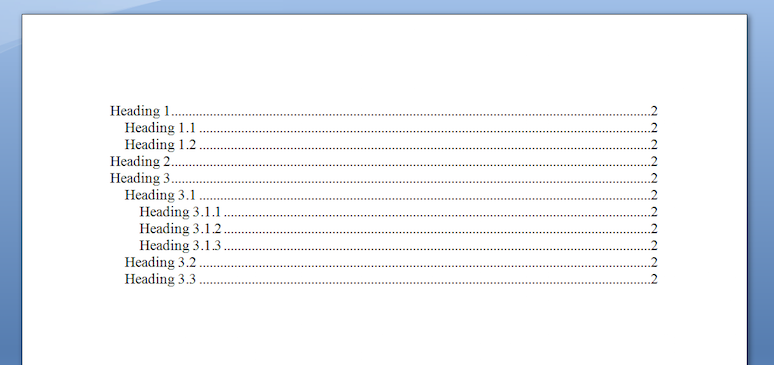Analyzing your prompt, please hold on...
An error occurred while retrieving the results. Please refresh the page and try again.
通常,您将处理包含目录(TOC)的文档。 使用Aspose.Words,您可以插入自己的目录,或者只需几行代码就可以完全重建文档中现有的目录。
本文概述了如何使用目录字段并演示:
TOC字段以及所有条目。您可以通过调用InsertTableOfContents方法将TOC(目录)字段插入到当前位置的文档中。
Word文档中的目录可以通过多种方式构建,并使用多种选项进行格式化。 传递给方法的字段开关控制了在文档中构建和显示表的方式。
在Microsoft Word中插入的TOC中使用的默认开关是**"\o “1-3 \h \z \u”**。 这些交换机的描述以及支持的交换机的列表可以在本文后面找到。 您可以使用该指南获得正确的开关,或者如果您已经有一个包含类似TOC的文档,您可以显示字段代码(*ALT+F9*)并直接从字段复制开关。
下面的代码示例演示如何将目录字段插入到文档中:
下面的代码示例演示如何使用标题样式作为条目将目录(TOC)插入到文档中:
该代码演示将新的目录插入到空白文档中。 然后使用DocumentBuilder类插入一些具有适当标题样式的示例内容格式,这些标题样式用于标记要包含在TOC中的内容。 接下来的行通过更新文档的字段和页面布局来填充TOC。

TOC字段,但没有可见的内容。 这是因为TOC字段已插入,但在文档中更新之前尚未填充。 有关这方面的进一步信息将在下一节中讨论。
Aspose.Words允许您只用几行代码就可以完全更新TOC。 这样做可以填充新插入的TOC,或者在对文档进行更改后更新现有的TOC。
必须使用以下两种方法来更新文档中的TOC字段:
请注意,需要按该顺序调用这两个更新方法。 如果反转,将填充目录,但不会显示页码。 可以更新任意数量的不同TOCs。 这些方法将自动更新文档中找到的所有TOCs。
下面的代码示例演示如何通过调用字段更新来完全重建文档中的TOC字段:
对Document.updateFields()的第一次调用将构建TOC,填充所有文本条目,并且TOC看起来几乎完成。 唯一缺少的是现在用"?“显示的页码。
对Document.updatePageLayout()的第二次调用将在内存中构建文档的布局。 这需要做收集条目的页码。 然后将从该调用计算出的正确页码插入TOC中。
与任何其他字段一样,TOC字段可以接受在控制内容列表构建方式的字段代码中定义的开关。 某些开关用于控制包含哪些条目以及在什么级别,而其他开关用于控制TOC的外观。 开关可以组合在一起,以允许产生一个复杂的目录。

默认情况下,在文档中插入默认TOC时包含上述这些开关。 没有开关的TOC将包括内置标题样式中的内容(就像设置了\O开关一样)。
下面列出了Aspose.Words支持的可用TOC开关,并详细描述了它们的用途。 它们可以根据类型分为不同的部分。 第一部分中的开关定义要包含在TOC中的内容,第二部分中的开关控制TOC的外观。
如果此处未列出交换机,则当前不支持该交换机。 所有交换机将在未来的版本中支持。 我们正在为每个版本增加进一步的支持。
| 开关,开关 | 资料描述 |
|---|---|
| Heading Styles (\O开关) |
此开关定义了
|
| Outline Levels (\U开关) |
每个段落都可以在段落选项下定义大纲级别。
请注意,内置标题样式(如Heading 1)在样式设置中必须设置大纲级别。
|
| Custom Styles (\T开关) |
此开关将允许在收集要在TOC中使用的条目时使用自定义样式。 这通常与\O开关一起使用,以包括自定义样式以及TOC中的内置标题样式。 将使用CustomHeading1样式的内容作为 |
| 使用TC字段 (\F和\L开关) |
在旧版本的Microsoft Word中,构建
这些字段可以像任何其他字段一样在任何位置插入到文档中,并由 将只包括TC字段,如
-\F-上面解释过。* –\L-定义此TC字段将出现在 -_\N-不显示此 |
| 开关,开关 | 资料描述 |
|---|---|
| Omit Page Numbers (\N开关) |
此开关用于隐藏TOC的某些级别的页码。 例如,可以定义 第3级和第4级条目上的页码将与领导者点(如果有的话)一起隐藏。 要仅指定一个级别,仍应使用范围,例如,“1-1"将仅排除第一级的页码。
|
| 插入为超链接 (\H开关) |
此开关指定
|
| Set Separator Character (\P开关) |
此开关允许在TOC中轻松更改分隔条目标题和页码的内容。 要使用的分隔符应在此开关后指定,并用语音标记括起来。
|
| Preserve Tab Entries (\W开关) |
使用此开关将指定具有制表符的任何条目,例如,在行尾具有制表符的标题,在填充TOC时将保留为适当的制表符。 这意味着制表符的功能将出现在
|
| Preserve New Line Entries (\X开关) |
与上面的开关类似,此开关指定跨越多行的标题(使用换行符,而不是单独的段落)将保留为生成的TOC中的标题。 例如,要跨多行分布的标题可以使用新行字符(Ctrl+Enter或
|
您可以通过调用DocumentBuilder.InsertField方法并将字段名称指定为"TC"以及所需的任何开关,在DocumentBuilder的当前位置插入新的TC字段。
下面的代码示例演示如何使用DocumentBuilder将TC字段插入到文档中。
通常为TOC指定特定的文本行,并用TC字段标记。 在MSWord中执行此操作的简单方法是突出显示文本并按ALT+SHIFT+O。 这会使用所选文本自动创建TC字段。 同样的技术可以通过代码来完成。 下面的代码将找到与输入匹配的文本,并在与文本相同的位置插入TC字段。 该代码基于文章中使用的相同技术。 下面的代码示例演示如何在文档中的文本中查找并插入TC字段。
TOC中的条目格式不使用标记条目的原始样式,而是使用等效的TOC样式对每个级别进行格式设置。 例如,TOC中的第一级用TOC1样式格式化,第二级用TOC2样式格式化等等。 这意味着要更改TOC的外观,必须修改这些样式。 在Aspose.Words中,这些样式由与语言环境无关的StyleIdentifier.TOC1到StyleIdentifier.TOC9表示,可以使用这些标识符从Document.Styles集合中检索。
一旦检索到文档的适当样式,就可以修改此样式的格式。 对这些样式的任何更改都将自动反映在文档中的TOCs中。
下面的代码示例更改第一级TOC样式中使用的格式化属性。
还需要注意的是,标记为包含在TOC中的段落(在段落本身上定义而不是在样式中定义)的任何直接格式都将复制到TOC中的条目中。 例如,如果Heading 1样式用于标记TOC的内容,并且此样式具有粗体格式,而段落也直接应用斜体格式。 生成的TOC条目不会是粗体,因为这是样式格式的一部分,但是它将是斜体,因为这是直接在段落上格式化的。
您还可以控制每个条目和页码之间使用的分隔符的格式。 默认情况下,这是一条虚线,使用制表符和靠近右边距的右制表位排列在页面编号上。
使用为要修改的特定TOC级别检索的Style类,还可以修改这些在文档中的显示方式。
要更改它的显示方式,首先必须调用Style.ParagraphFormat来检索样式的段落格式。 由此,可以通过调用ParagraphFormat.TabStops检索选项卡停止,并修改相应的选项卡停止。 使用相同的技术,选项卡本身可以完全移动或删除。
下面的代码示例演示如何在TOC相关段落中修改右制表符停止的位置。
通过删除在TOC字段的FieldStart和FieldEnd节点之间找到的所有节点,可以从文档中删除目录。
下面的代码演示了这一点。 删除TOC字段比普通字段简单,因为我们不跟踪嵌套字段。 相反,我们检查FieldEnd节点的类型为FieldType.FieldTOC,这意味着我们遇到了当前TOC的结尾。 这种技术可以在这种情况下使用,而不必担心任何嵌套字段,因为我们可以假设任何正确形成的文档在另一个TOC字段中没有完全嵌套的TOC字段。
首先收集并存储每个TOC的FieldStart节点。 然后枚举指定的TOC,以便访问并存储字段中的所有节点。 然后从文档中删除节点。 下面的代码示例演示如何从文档中删除指定的TOC。
如果要从任何Word文档中提取目录,可以使用以下代码示例。
Analyzing your prompt, please hold on...
An error occurred while retrieving the results. Please refresh the page and try again.